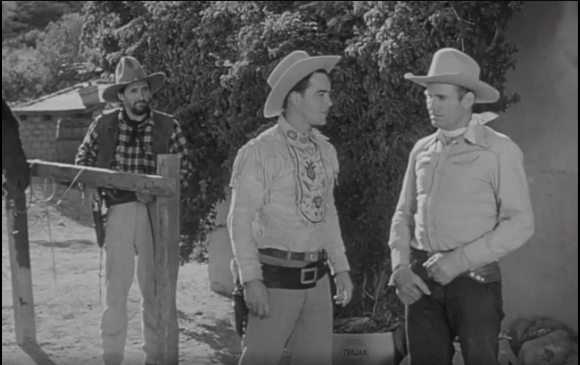What I watched: The fifteenth episode of The Gene Autry Show, a kid-friendly Western starring the titular singing cowboy and his sidekick Pat Buttram. “Gun Powder Range” was directed by George Archainbaud and written by Kenneth Perkins, with guest stars Gail Davis, Dick Jones, George J. Lewis, and Kenneth MacDonald. The episode originally aired at 7:30 PM on Sunday, October 8, 1950 on CBS, and is available on Shout Factory TV.
What happened: We’re introduced to Jim (Jones), a dishwasher at a picturesque cafe who wants to be a “bad man” and carries a gun. After showing off his sharpshooting skills, a man from the “Red Wolf Bunch” named Chipote (Lewis) expresses interest in having Jim (Davis) join his gang. His sister Millie, a waitress at the cafe, tries to warn him about getting involved with a bad crowd. He gets passers by to bet on whether or not Jim can shoot 4 out of 5 silver dollars out of the air.
Gene and Pat ride into town, looking for the waitress, who has written him a letter. Along the way they run into a bank raid, and get into a shootout. One of the bad guys falls off a cliff and surely dies. The sheriff, Jack (MacDonald), suspects that the Red Wolf gang planned the raid, and used Tim’s shooting show as a distraction. The sister protests his innocence, but Jack arrests him anyways. Tim puts up a fight and escapes.

Millie meets up with Gene, and we learn that she wrote him a letter to try to talk some sense into the adventure-hungry Tim. Gene hasn’t seen him since he was 5, but he is very persuasive. Gene and Pat catch up with Tim entering a cabin in the wilderness. They decide to teach Tim “what a bad man’s life is really like”, and Pat is very excited about getting to be evil for a change. Nonetheless, Tim quickly shoots off his hat.
Gene sneaks up behind Tim, but doesn’t draw on him. He claims to be a member of the Red Wolves, looking to recruit him, but warns that outlaws’ lives are lonely and dangerous. Pat bumbles in, acting like he’s shooting someone. He’s already notched his gun to suggest that he’s killed almost a dozen men this season. Tim thinks this is very cool and agrees to walk the “outlaw’s trail” with them. Tim’s enchantment quickly dries up after hiking up a harsh trail with no water, in the name of trying to avoid the law. Gene sings about being in the middle of the desert without a drop to drink. Sounds like my dating life.
Meanwhile, the real Red Wolves find out that someone else is going around using their water holes and claiming that they’re with them. Tim finds two famished men by the side of the road, and gives them his canteen of water. After he leaves, the Red Wolves get into a shootout with the two men and kill them. Gene and Pat laugh at Tim’s generousity. Sheriff Jack find Tim’s canteen at the site of the shooting and assume he’s guilty. They arrest our fake outlaw trio, fooled by the notches on Pat’s gun. Gene knocks out the officer of the law and takes off.
Chipote arrives with one of his henchmen to testify against the remaining heroes, and the law makes like it’s going to hang Tim and Pat right there on the spot, until Gene comes back with the surviving desert rat, who says that Chipote is to blame. The bandit leader flees, but Gene chases him down and gets into a shootout. Eventually Chipote falls down trying to climb some rocks, leading to his capture. Tim has learned his lesson, but still seems pretty trigger-happy.
What I thought: This episode basically echoes the first Gene Autry episode I saw, “The Star Toter”. In that episode, Gene helps a young boy break away from the influence of his outlaw father. At the time I felt this was a refreshing change from the less character-focused Western stories I had been inured to from 50+ episodes of The Lone Ranger.
“Gun Powder Range” revisits this premise, but with an older boy and a more action-packed episode. Instead of a wayward child with torn loyalties, Tim is simply foolish, and needs to be “scared straight” by Gene and Pat. It’s a pretty thin story, but it does have some moments, especially when Pat tries to impersonate an outlaw (perhaps the first time he’s actually been funny.)
Again, we see that, while the story is ostensibly about the need to keep on the straight and narrow, the forces of law and order are not terribly reliable. One piece of false testimony is enough to get the sheriff’s men to almost string up a teenage boy on the spot. When I was watching this scene I assumed that Gene and Pat had arranged this impromptu execution as part of their lesson-teaching plan, but apparently the sheriff’s department really are just this bloodthirsty.

In the end, the day is saved, but Tim still seems pretty unbothered. Maybe not everyone can be perfectly redeemed, no matter how many times you try to scare them straight.
Coming up next: I’m going to be presenting the long-delayed 3rd Golden Potato Awards, but after that it’s the KFO gang to kick off the week with Halloween Eve. They probably won’t call it Devil’s Night.

















